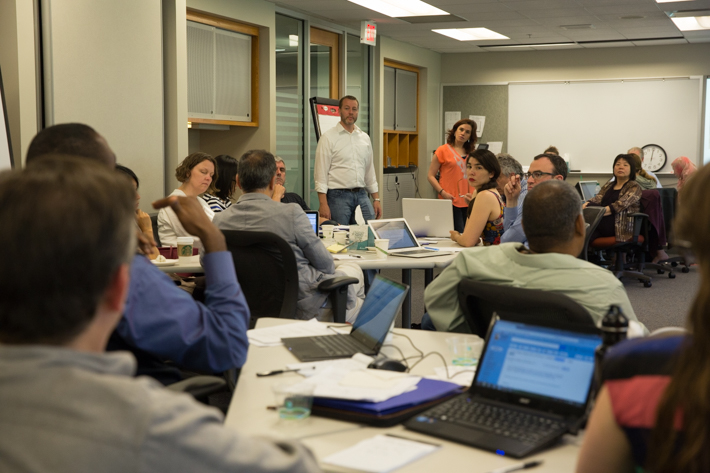By Ruth Steinhardt
Seated around tables crowded with laptops, books and papers, the group of learners in a large seminar room in the George Washington University’s Gelman Library looked like students cramming for a final exam.
But these weren’t typical college students. The site was GW’s first Course Design Institute (CDI), and the participants were GW faculty members, some with decades of classroom experience, all there to learn new ways to structure a college class.
A four-and-a-half day boot camp, the CDI is the brainchild of the University of Virginia’s Teaching Resource Center with leadership by chemistry Professor Michael Palmer and was brought to campus by GW’s University Teaching and Learning Center. Dr. Palmer, who came to GW to facilitate the program along with psychology Professor Cara Meixner from James Madison University, said its purpose is to help faculty think about a class as more than its content. It aims to get professors to think about student motivation, creative assessment, educational psychology and neuroscience as well as the basic requirements of their discipline. Courses can then be reverse-engineered from broad learning goals, rather than being generated from the pages of a textbook.
“We know the best learning environment is when you as a professor help students discover value in what you’re doing,” Dr. Palmer explained. “[Achieving] that has to do with emotions. But across the board, instructors tend to ignore the affective side.”
Working in teams grouped by discipline or pedagogical interest, participants spend the week brainstorming, sharing experiences and learning what makes a course tick. By the end of the week, they’ve created a new or redesigned project: a new or redesigned course syllabus, one that Dr. Palmer explains is “learning-focused” rather than “content-focused.”
That means the syllabus, rather than being merely a calendar of assignments or summary of a textbook’s table of contents, lays out the larger-term goals of the class: enhancing students’ ability to read and think critically, for example, or using material from math and science classes to solve real-world biology problems.
Tara Scully had been teaching biology for 11 years when she went to her first CDI last year at the University of Virginia. Like many, if not most, professors, in some courses she used a revamped syllabus provided by her predecessor, with her own revisions and additions. “I thought that was enough to make it my own,” she said.
And how soon did she start to re-evaluate? “Within five minutes” of settling in at CDI, she said, laughing.
“I thought of a syllabus as a technical document,” she said. “But it’s more than that. This is not something that you just throw out the first day to explain how you’ll be grading, although essentially that’s how everybody thinks of a syllabus. Instead, it was designed to explain to students how they would take away information from this class that they’d carry with them the rest of their life and maybe impart to other people.
“So it just changed their attitude towards the topics that I teach. And as soon as I changed it, I got more interesting questions from my students.”
Patricia Dinneen, director of the UTLC, also attended a CDI last year, and said she was inspired to bring it to GW by “the energy in the room.”
“We tried to find someone who hadn’t enjoyed it or learned something, and we couldn’t,” she recalled. “Part of what is special about CDI is that it gets faculty talking with each other and helps remind them what excites them.”
She said she hopes to make CDI an ongoing event, with this first group of peers helping to shape and refine it for GW.
“Once we have a group that’s gone through this, then people will have a common language, and they’ll have a support system,” she said.
Not surprisingly, Dr. Palmer thinks “everyone should do CDI. I think they’d be happier, their students would be happier, and we’d really move higher education forward.”
For Tara Scully, CDI has opened up new possibilities. During the course of the GW CDI May 18-22, she figured out a way to take an assignment that she had used previously only in lectures and integrate it into the lab portion of her classes. Doing so, she said, will create a more cohesive experience for her learners.
“Honestly, I wish I could start teaching tomorrow,” she said.


